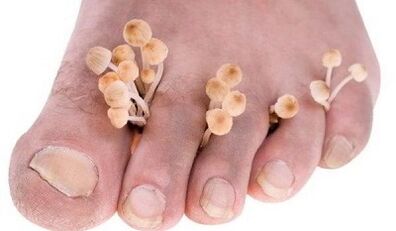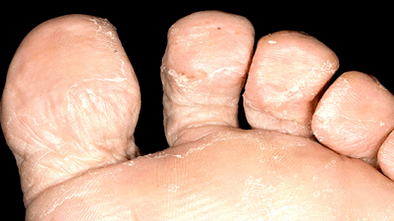The mushroom between the fingers of the feet is a disease that is very easy to collect.But get rid of him is far from so easy.The disease can last for years, often a bacterial infection combines.When the first symptoms appear, it is very important to contact a dermatologist and not be self -proclaimed.
Because the mushroom develops between the fingers of the feet

The mushroom between the toes is the most common type of fungal infection, which occurs in 70% of the population of our planet.This disease is particularly common among people who find themselves constantly in a humid or warm environment, often sweaty due to a high physical effort.These include Stendardi, swimmers, employees of hot seminars and so on.Children are sick much less often (no more than 4%), but the incidence increases dramatically in adolescence.
The disease is caused by various species of dermatophilic mushrooms: red Trichophophyton, Trichophytone Interdaltsev and some types of epidermofiton.All these pathogens are distinguished by a high degree of survival in the environment.They can last for a long time on the floors in the bathing establishment and sauna, bath equipment, linen, shoes.
You can be infected in a bathroom, sauna, swimming pool, less often on the beach.Therefore, it is so important to observe the rules of hygiene: to use only an individual towel, do not walk barefoot in public places, using the individual shoes for this.
Once on the body surface, mushrooms produce enzymes (keratinase) that decompose keratin - the protein of surface leather layers.This allows the infection to penetrate the epidermis and multiply there.Mushroom cell membranes contain substances (manners) that can inhibit local immunity.The hands also suppress the reproduction of the surface cells of the epidermis, due to which their desquamation and purification are disturbed, which consequently leads to a prolonged and chronic course of the disease.
Factors that contribute to the spread and implementation of the mushroom
These factors include:
- shoes that tighten the legs that violate blood circulation and do not pass air;
- practice sports and heavy physical work;
- feet trauma with a violation of the skin;
- altered immunity, for example, against the background of diabetes, prolonged administration of some drugs (glucocorticoid hormones), HIV infection;
- Violation of the blood circulation in the foot of the feet against the background of the atherosclerosis of the lower limbs, the flat feet and so on.
If a person has a normal general and local immunity, the mushroom will not be able to overcome the protective barrier of the skin and infiltrate the skin.All factors that suppress skin immunity allow to introduce pathogenic mushrooms into the epidermis without obstacles, causing a pathological process.
Symptoms of infection
When it introduces pathogenic mushrooms into the skin, mainly areas with thin and delicate skin are influenced by interdigital gaps.This is where the infection begins, which can therefore spread to the entire foot.The first thing an infected person experiences is itching and burning between the fingers of the feet.
The itch can be very strong, or it can be insignificant or even completely absent and appear only against the background of the sweating of the feet or a decrease in immunity.Significant itching, dryness, painful cracks in the interdigital spaces contribute to the addition of bacterial infection and the development of purulent processes.
Sometimes the slow bubbles appear between the fingers, full of transparent liquid, which open quickly, forming erosion.And this type of disease can be complicated by the addition of a bacterial infection.
The most characteristic of the hidden course of the mushroom between the fingers of the feet, which is characterized by itch periodically.Often these patients do not suspect the presence of infection and spread it among others.
How the disease flows
The mushroom can manifest itself in different ways.The following forms of the disease are distinguished:

- Intriguing- the most common;It manifests itself in the form of itching and burning between the fingers, dryness, cracks with the release of the lag and the subsequent development of the maceration (loosening of the skin under the influence of the liquid);Inflammation often passes to the foot surface of the feet and almost never on the back;The bacterial infection often combines;
- Dyshidrotic- with the advent between the fingers of the stops of the slow and burst bubbles, the formation of erosion, the introduction of bacterial pathogens and the development of the pathological process based on the type of eczema, which spreads to the entire foot, leg and even the body;
- deleted- flows unnoticed;A slight itching occasionally arises;Moderate subtle peeling appears between the fingers of the feet (most often between 1 and 2 or 5), very small, unnoticed by patients of cracks.
The mushroom in the interdigital gaps can occur as an independent disease or is a manifestation of a general infection.Often the mushroom passes to nail plates with the development of onychomycosis.Sometimes there is a combined lesion of the skin of the feet and skin in the area of large folds on the body, as well as the hands.In the latter case, the infection often develops on the principle of "two feet - a brush".
How to identify an infection
The diagnosis is carried out on the basis of an examination of a dermatologist and is confirmed by the laboratory research:
- The microscopy method- under the microscope, the skin elements (stairs) taken from the injury are examined;This is the most common method, it allows you to identify a fungal infection, but cannot determine the type of mushroom;
- Microbiological examination- sowing of biological material taken from the lesion, to the nutritional media;Mushrooms on the ground are easy to identify, but do not always give growth in laboratory conditions, therefore it often remains to focus only on the microscopy method.
The basic principles of treatment
For the treatment of the mushroom of the interdigital gaps, antifungal drugs are used.If the disease does not proceed for a long time, it does not advance, external funds are used.In serious fungal infections with a tendency to spread or develop microbial eczema, general antifungal drugs of general action (system) are used.
The external use of antifungini agents requires preliminary preparation.The pathologically altered skin elements are removed from the surface of the skin: peeling, destroy the places and remains of bubbles burst.They try to relieve inflammation and swelling of the tissues, if possible.
Conduct the following procedures:
- If there is an inflammation and swelling pronounced of the fabrics, the lotions are prescribed with 2% solutions of boric acid, special ointments;If it does not help, corticosteroid ointments are prescribed in short courses;
- In the presence of stairs and crusts, the affected areas of the body surface twice a day are lubricated with salicylic oil jelly and therefore bath baths are performed with a 2%soda solution.
Only after cleaning the main treatment is performed.If there is the suspicion of mixed fungal-bacterial infection, combined ointments are used, which include antifungal, antibacterial and anti-allergic components.
Drug therapy
The most modern drugs for the treatment of these diseases are drugs, whose active substance is terbinophine, which is part of the products of external use produced by various pharmaceutical companies under their commercial names.These are creams, gels, sprays and solutions for external use.
This substance easily enters the epidermis.Already 4 hours after applying its concentration, its concentration is sufficient to suppress the vital activity of the infection.The concentration of the product gradually accumulates in the skin and after the therapy it is many times higher than the concentration that causes the death of the mushrooms.Furthermore, it does not penetrate the medium and deep layers of the skin and does not have a systemic effect on the body.A characteristic of the antifungal agent is that it has an antibacterial effect, which suppresses the vital activity of most pathogenic bacteria.Therefore, for the treatment of fungal-bacterial infection, additional antibacterial therapy is not always necessary.
Cream, spray and gel are applied to the pathologically altered areas of the feet every day for 7 days.Usually this is enough to completely cross all the symptoms of the infection.If necessary, a dermatologist can extend the course of treatment.
With the ineffectiveness of the external treatment and common forms, often recurring of the disease, are prescribed, antifungal drugs of general action are prescribed.
With the development of microbial eczema, a complex treatment is prescribed, which includes antifungal drugs, antibiotics and desensitizing agents that reduce allergic mood, inflammation and edema of tissues.With serious allergic and inflammatory processes, glucocorticoid hormones are included in the complex treatment.
Popular remedies against the interdalciale mushroom
Popular remedies can also be effective if they are used correctly.Traditional medicine recommends that before starting antifungal treatment, the preparatory treatment for cleaning the pathologically altered areas of the surface of the feet.Cleaning is performed in the same way as pharmacological treatment.Subsequently, fixed resources are used to suppress the vital functions of mushrooms.
- Method 1.Twice a day, for 2-3 weeks, they make the legs for the legs with an infusion of curtains of a large (a third of a glass of budding crushed per liter of boiling water) and then lubricate the dry surface of the feet with 10% of propolis tincture.
- Method 2.Add 20 ml of ammonia to a glass of water, moisten the bandage, wrap your fingers first and then the entire foot (do not tighten!) And left until drying;The duration of the treatment is 14 days.
- Method 3.Bagni Pode with Air (for 2 liters of water - 100 ml of table vinegar).They are kept every day before bedtime for 14 days.After the procedure, dry the legs and sprinkle them slightly with boric acid.
- Method 4.Necessary bathrooms with a touch of trees (20 g of Mahorka for 1 liter of boiling water, they insist 3-4 hours in a thermos).Do every day before bedtime for four weeks.After the procedure, the legs must dry out.In the morning, wash your feet with water.
- Method 5.Wash your feet with home soap, washing carefully between your fingers.Dry the legs and grease the skin with the curtain juice.Do it every day for 14 days.
- Method 6.Daily legs for the legs with 2%soda solution.After the bath, dry the legs with a towel and a fat with garlic oil.In the morning, wash them with soap.Garlic oil: Mix a teaspoon of oured garlic from 100 g of butter until a homogeneous mass is obtained.
- Method 7.Take an equal amount of apple cider vinegar and newly squeezed carrot juice.Apply the resulting mixture to the interested areas of the skin of the feet several times a day for a month.
How to warn the infection
To prevent the disease, it is necessary:
- Wear rubber scans in a bathroom, sauna, swimming pool, on the beach;
- Never wear someone else's shoes, do not use someone else's towels and accessories;
- In the hot season, wear shoes or sandals from light natural materials that pass air and absorb humidity;
- To conduct a pedicure, use only individual or disposable tools.
To prevent the re -infection it should be:
- Treat the internal surface of shoes with disinfectant solutions, for example formaline solutions or vinegar essence;Two days after this processing, the death of all infectious pathogens occurs.
The mushroom between the fingers of the feet is well lent to therapy with modern anti -flaunga agents and popular methods.But it is very important to make every effort so that there is no infection, also through your shoes and other objects for personal use.
















